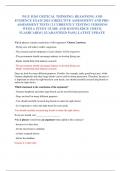Popular courses 'TNCC' at TNCC
TNCC Study guides, Study notes & Summaries
Looking for the best study guides, study notes and summaries about TNCC? On this page you'll find 4287 study documents about TNCC.
All 4.287 results
Sort by
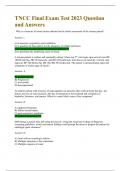 Popular
Popular
-
TNCC Final Exam Test 2023 Question and Answers – Open Book
- Exam (elaborations) • 13 pages • 2023
-
- R314,23
- 10x sold
- + learn more
TNCC Final Exam Test 2023 Question and Answers – Open Book Why is a measure of serum lactate obtained in the initial assessment of the trauma patient? A trauma patient is restless and repeatedly asking "where am I?" vital signs upon arrival were BP 100/60 mm Hg, HR 96 beats/min, and RR 24 breaths/min. Her skin is cool and dry. Current vital signs are BP 104/84mm Hg, HR 108, RR 28 breaths/min. The patient is demonstrating signs and symptoms of which stage of shock? An elderly patient wi...
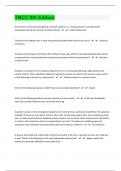 Popular
Popular
-
TNCC 8th Edition 50 Questions and Answers
- Exam (elaborations) • 7 pages • 2023 Popular
-
- R152,26
- 5x sold
- + learn more
The trauma nurse knows that placing a bariatric patient in a "ramped position" provides better visualization during the insertion of which device? - endotracheal tube Tearing of the bridging veins is most frequently associated with which brain injury? - subdural hematoma A patient is found lying on the floor after falling 13 hours ago. Which of the following laboratory values is expected with a musculoskeletal complication associated with this presentation? - Elevated creatine kinase...
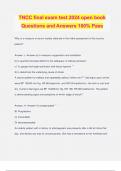
-
TNCC final exam test 2024 open book Questions and Answers 100% Pass
- Exam (elaborations) • 19 pages • 2024
-
- R238,01
- + learn more
TNCC final exam test 2024 open book Questions and Answers 100% Pass Why is a measure of serum lactate obtained in the initial assessment of the trauma patient? Answer: c -Answer-a) to measure oxygenation and ventilation b) to quantify the base deficit for the adequacy of cellular perfusion c) *to gauge end-organ perfusion and tissue hypoxia ** d) to determine the underlying cause of shock A trauma patient is restless and repeatedly asking "where am I?" vital signs upon arrival were BP...
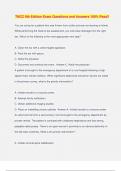
-
TNCC 9th Edition Exam Questions and Answers 100% Pass!!
- Exam (elaborations) • 14 pages • 2024
-
- R238,01
- + learn more
TNCC 9th Edition Exam Questions and Answers 100% Pass!! You are caring for a patient who was thrown from a bike and was not wearing a helmet. While performing the head-to-toe assessment, you note clear drainage from the right ear. Which of the following is the most appropriate next step? A. Clean the ear with a cotton-tipped applicator. B. Pack the ear with gauze. C. Notify the physician D. Document and continue the exam. -Answer-C. Notify the physician A patient is brought to the emerge...
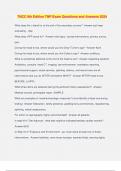
-
TNCC 9th Edition TNP Exam Questions and Answers 2024
- Exam (elaborations) • 22 pages • 2024
-
- R238,01
- + learn more
TNCC 9th Edition TNP Exam Questions and Answers 2024 What does the J stand for at the end of the secondary survery? -Answer-just keep evaluating - vipp What does VIPP stand for? -Answer-vital signs, injuries/interventions, primary survey, pain During the head-to-toe, where would you find Grey-Turner's sign? -Answer-flank During the head-to-toe, where would you find Cullen's sign? -Answer-umbilicus What is sometimes deferred at the end of the head-to-toe? -Answer-inspecting posterior An...
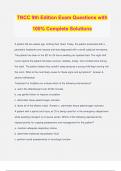
-
TNCC 9th Edition Exam Questions with 100% Complete Solutions
- Exam (elaborations) • 6 pages • 2024
- Available in package deal
-
- R218,95
- + learn more
TNCC 9th Edition Exam Questions with 100% Complete Solutions A patient fell two weeks ago, striking their head. Today, the patient presented with a persistent headache and nausea and was diagnosed with a small subdural hematoma. The patient has been in the ED for 24 hours awaiting an inpatient bed. The night shift nurse reports the patient has been anxious, restless, shaky, and vomited twice during the night. The patient states they couldn't sleep because a young child kept coming into t...
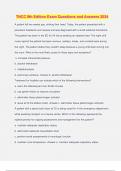
-
TNCC 9th Edition Exam Questions and Answers 2024
- Exam (elaborations) • 6 pages • 2024
- Available in package deal
-
- R218,95
- + learn more
TNCC 9th Edition Exam Questions and Answers 2024 A patient fell two weeks ago, striking their head. Today, the patient presented with a persistent headache and nausea and was diagnosed with a small subdural hematoma. The patient has been in the ED for 24 hours awaiting an inpatient bed. The night shift nurse reports the patient has been anxious, restless, shaky, and vomited twice during the night. The patient states they couldn't sleep because a young child kept coming into the room. What...
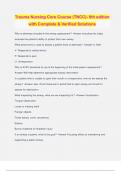
-
Trauma Nursing Core Course (TNCC)- 9th edition with Complete & Verified Solutions
- Exam (elaborations) • 3 pages • 2024
- Available in package deal
-
- R199,90
- + learn more
Trauma Nursing Core Course (TNCC)- 9th edition with Complete & Verified Solutions Why is alertness included in the airway assessment? -Answer-Including this helps evaluate the patient's ability to protect their own airway What pneumonic is used to assess a patient level of alertness? -Answer-A: Alert V: Responds to verbal stimuli P: Responds to pain U: Unresponsive Why is AVPU beneficial to use at the beginning of the initial patient assessment? - Answer-Will help determine appropriate...
ALL TNCC EXAMS COMPILATION BUNDLE|DOWNLOAD TO PASS
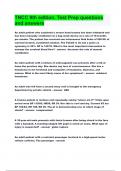
-
TNCC 9th edition. Test Prep questions and answers
- Exam (elaborations) • 6 pages • 2024
-
- R304,70
- + learn more
An adult patient who sustained a severe head trauma has been intubated and has been manually ventilated via a bag mask device at a rate of 18 breaths per minute. The patient has received one intravenous fluid bolus of 500 ML of warmed isotonic crystalloid solution. The PaCO2 is 30 and a pulse ox symmetry is 92%. BP is 142/70. What is the most important intervention to manage the cerebral blood flow? decrease the rate of manual ventillation An older patient with a history of anticoagulant...
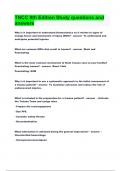
-
TNCC 9th Edition Study questions and answers
- Exam (elaborations) • 18 pages • 2024
-
- R285,65
- + learn more
Why is it important to understand biomechanics as it relates to types of energy forces and mechanism of injury (MOI)? To understand and anticipate potential injuries. What are common MOIs that result in trauma? Blunt and Penetrating What is the most common mechanism of blunt trauma seen at your facility? Penetrating trauma? Blunt- Falls Penetrating- GSW Why is it important to use a systematic approach to the initial assessment of a trauma patient? To maximize outcomes a...

R115 for your summary multiplied by 100 fellow students... Do the math: that's a lot of money! Don't be a thief of your own wallet and start uploading yours now. Discover all about earning on Stuvia

